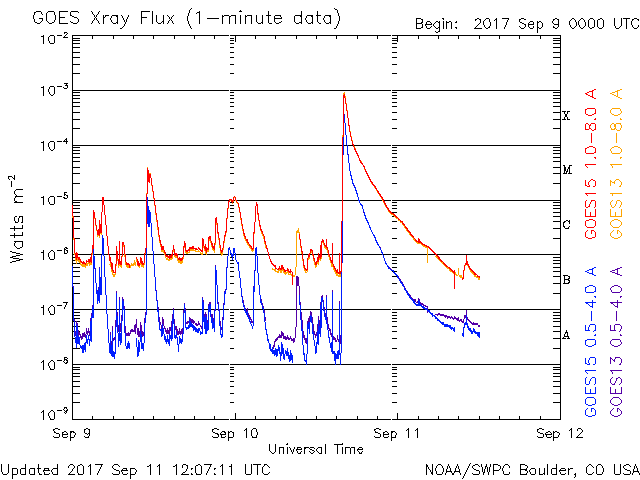Space Weather Alert - 11th September 2017
What Has Happened?
After a very busy week last week the Sun has continued to be very active over the weekend. Just a few days after we saw the largest solar flare of this cycle (X9.3), the Sun has unleashed the second largest, this time reaching X8.3-class, at around 16:00 UT (17:00 BST) on 10th September.
Despite the active region responsible having rotated off the Earth-facing disc of the Sun the coronal mass ejection (CME) associated with this flare is large enough that we expect at least some of it to hit the Earth.
The estimated velocity of the CME is very high at around 2000km/s, and while we are not directly in the path of the full CME we expect to get a significant glancing blow. Current estimates of arrival time suggest anywhere between this afternoon (11th) and early on 13th September, showing just how tricky it is to predict with the information available.
Following the arrival of the CME there is a chance geomagnetic activity may reach as high as STORM G3 levels, particularly if it reaches Earth on the earlier side of the estimates, and the magnetic field in the CME couples strongly with the Earth's magnetic field.
Assuming clear dark skies there is an increased chance of seeing the aurora either tonight (11th) or tomorrow night (12th). In the UK, those in Scotland, northern England and Northern Ireland may have the best opportunities, those further south may also see something if the activity does reach STORM G3 levels.
Sign-up to receive Geomagnetic Disturbance Alert emails.
Follow us on Twitter:
Follow @BGSauroraAlert for more occasional aurora alerts.
Follow @BGSspaceWeather for daily space weather forecasts.
Glossary
- BGS
- The British Geological Survey is one of the Natural Environment Research Council's Research Centres.
- CME or Coronal Mass Ejection
- The eruption of a portion of the outer atmosphere of the Sun into space, caused by rapid changes in its magnetic field. Often occurs along with a solar flare.
- Solar Flare
- Energy released by the explosive reorganisation of magnetic fields within the Sun's atmosphere.
- Magnetogram
- The variation, minute by minute, of the strength and direction of the Earth’s magnetic field. Measured in units of nano-Tesla (for the strength of the field) or in degrees (direction of the field).
- Solar Wind
- The ever-present expansion of the Sun’s hot outer atmosphere into the solar system, which carries space weather within it.
- Sunspot/Active Region
- A region of intense magnetic field in the Sun's visible outer atmosphere often associated with flares and CMEs.



